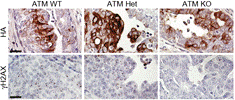Veterinary and Biomedical Sciences, Department of
Document Type
Article
Date of this Version
2016
Citation
Journal of Visualized Experiments 88 (June 2014), e51654. doi:10.3791/51654
The video component of this article can be found at http://www.jove.com/video/51654/
Abstract
Myocarditis is an inflammation of the myocardium, but only ~10% of those affected show clinical manifestations of the disease. To study the immune events of myocardial injuries, various mouse models of myocarditis have been widely used. This study involved experimental autoimmune myocarditis (EAM) induced with cardiac myosin heavy chain (Myhc)-α 334-352 in A/J mice; the affected animals develop lymphocytic myocarditis but with no apparent clinical signs. In this model, the utility of magnetic resonance microscopy (MRM) as a non-invasive modality to determine the cardiac structural and functional changes in animals immunized with Myhc-α 334-352 is shown. EAM and healthy mice were imaged using a 9.4 T (400 MHz) 89 mm vertical core bore scanner equipped with a 4 cm millipede radio-frequency imaging probe and 100 G/cm triple axis gradients. Cardiac images were acquired from anesthetized animals using a gradient-echo-based cine pulse sequence, and the animals were monitored by respiration and pulse oximetry. The analysis revealed an increase in the thickness of the ventricular wall in EAM mice, with a corresponding decrease in the interior diameter of ventricles, when compared with healthy mice. The data suggest that morphological and functional changes in the inflamed hearts can be non-invasively monitored by MRM in live animals. In conclusion, MRM offers an advantage of assessing the progression and regression of myocardial injuries in diseases caused by infectious agents, as well as response to therapies.
Included in
Biochemistry, Biophysics, and Structural Biology Commons, Cell and Developmental Biology Commons, Veterinary Infectious Diseases Commons, Veterinary Microbiology and Immunobiology Commons, Veterinary Physiology Commons



Comments
Copyright © 2014 Journal of Visualized Experiments. Used by permission.